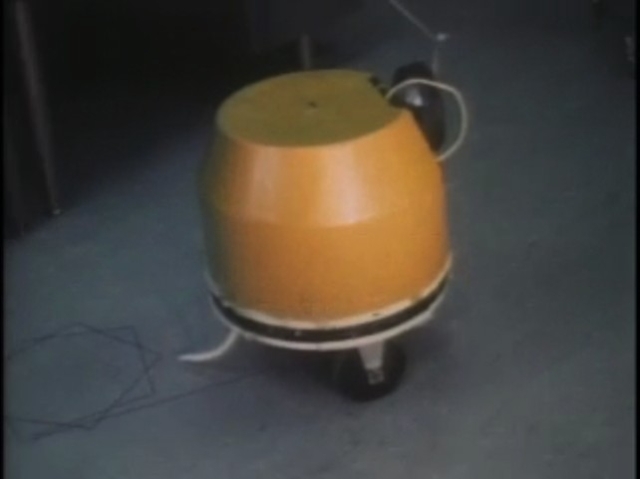
2. The minimal form of a moveable object ie tri-cycle, small bodied.
3. The inclusion of a clear shell ( supporting the argument that if you can see under the covers, it will aid your understanding somewhat).


Perspective on Logo's Early Years, Legacy, and
Ongoing Potential
Wallace Feurzeig, Principal Scientist, Learning Systems, BBNT, Cambridge, Massachusetts, USA
In 1971, visiting consultant Mike Paterson introduced the Logo-controlled robot turtle, a "floor turtle" physically connected to the computer via hardwire lines. As the turtle moved, it dragged the connecting wire along with it. Using Logo turtle commands, a student could command the turtle to move forward or back a specified distance, turn to the right or left a specified angle, sound its horn, use its pen to draw, and sense whether contact sensors on its antennas encountered an obstacle. "Screen turtles" were introduced at the MIT Logo Lab around 1972.
In 1972, BBN engineer Paul Wexelblat designed and built the first wireless floor turtle, "Irving." Irving was a remote-controlled RF turtle about one foot in diameter. It was capable of moving freely under Logo commands via a radio transceiver attached to a teletype terminal connected to a remote computer. We were interested in seeing whether elementary and junior high school students could control Irving to do simple Al tasks such as avoiding obstacles while circumnavigating an area. However, Irving initially lacked touch sensors, so it was not able to detect obstacles. Before we settled on bumpers as the appropriate device for touch sensors, we considered the use of antennas. (If we had done that, we might have called Irving a beetle instead of a turtle!)
During this phase of Irving's development, we wondered what kind of Al task, if any, was feasible for a robot without sensory feedback. On the face of it this seemed impossible—intelligent behavior requires feedback from the environment. However, we conceived a kind of limiting case, the "path reversal" task. The first part of the task was to move Irving from its initial room location to an adjoining room where it was no longer visible. This typically required a sequence of about twenty move and turn commands. After Irving was out of view, the challenge was to bring it back "home," to its starting point in the original room, only through the use of Logo commands, without peeking into the adjoining room, for example.
The student had a complete record of the sequence of commands she had used to control Irving, since each command was printed on the teletype. Students were typically taken aback, because they could no longer see the turtle when it was in the adjoining room. How could they control what they couldn't see? The task was compelling and, for all but the most sophisticated children, seemed non-trivial. Even bright students were initially perplexed. The notion that there is an algorithm for accomplishing it was not obvious. They knew that Forward and Back are inverse operations, as are RightTurn and LeftTurn, and PenUp and PenDown. But they didn't know how to use this for reversing Irving's path.
However, once students were asked how they could make Irving undo its last move so as to get where it had been "the time before last," most had a rapid flash of understanding and knew how to complete the entire path reversal. They saw that the way to return the turtle home is to undo the sequence of actions that the turtle took to reach its final location by performing the sequence of opposite actions in the reverse order.
The path reversal algorithm, an instance of the algorithm for inverting a functional chain, is a mathematical idea of considerable power with a wide range of application. It is the basis for matrix inversion and the solution of linear systems. It has important applications in thermodynamics and system design. It ought to be given a memorable name, such as "the theorem of return." The use of the turtle made it accessible to beginning students.
The path reversal activity directly paved the way for developing a procedure for solving linear equations in algebra. We introduced fifth-grade students to Logo in Cambridge the following year to show that the use of Logo could overcome traditional difficulties in learning algebra. Students worked with tasks like making and solving "secret codes," represented as Logo procedures. Functions and algorithms became familiar objects created to serve purposes that were interesting to them. Students were delighted to find that the algorithm for solving a linear equation—doing the inverse of the operations that generated the equation, but in the reverse order—is the same algorithm that was effective for path reversal.
Something else happened that summer[1972]. Marvin [Minsky], Seymour [Papert], and I along with Russell Noftsker and Seymour's brother Alan planned to make turtles available through a new company called General Turtle.
I have a few moments to go through your story on Logo/Turtles more thoroughly. Still fitting it in a bit, but a least I can be a bit more systematic.
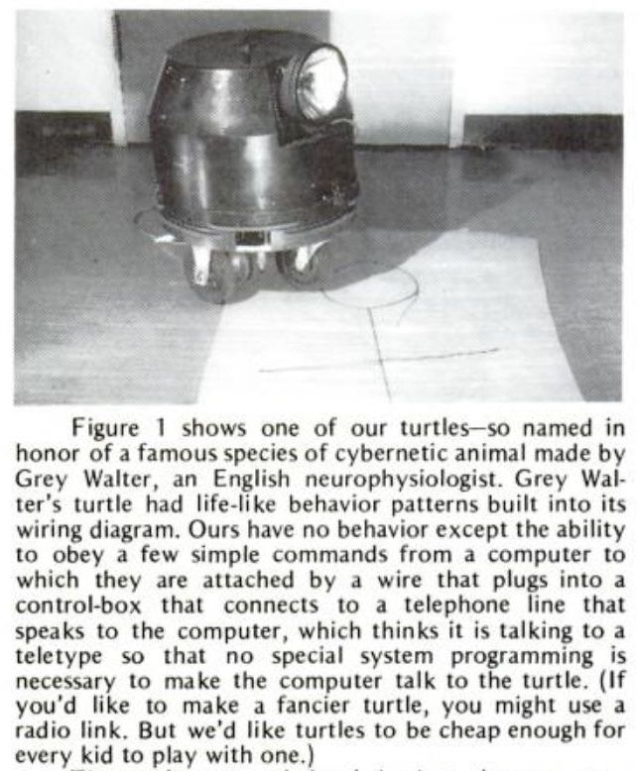
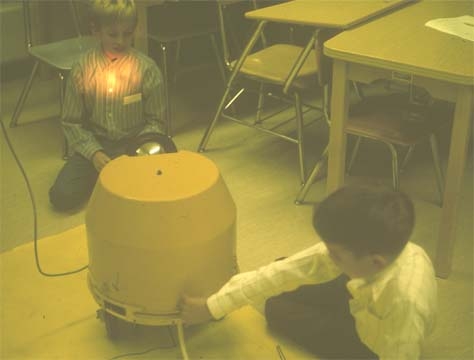
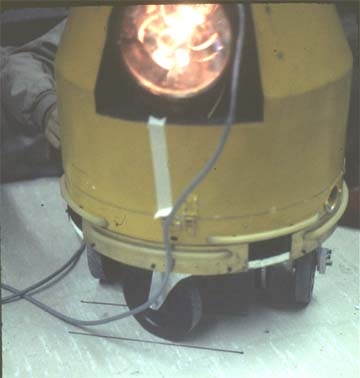
See video clip of logo yellow turtle – MIT on youtube here.
See all the original MIT LOGO and or Turtle film clips here.
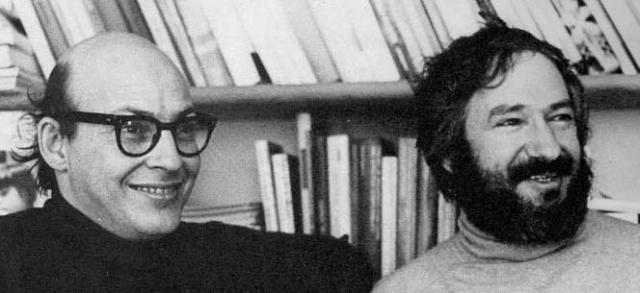
Marvin Minsky (left) and Seymour Papert (right) 1971 c Cynthia Solomon
Professor Minsky was also one of the pioneers of intelligence-based mechanical robotics and telepresence. He designed and built some of the first mechanical hands with tactile sensors, visual scanners, and their software and computer interfaces. He also influenced many robotic projects outside of MIT, and designed and built the first LOGO "turtle."
Note: RH 2010 -Although the above claim, in all of my research on Cybernetic Animals it is usually the leader of the team or the supervising professor for a thesis that gets the credit of "creating or building" something. Wherever possible, I will include the name of the technician/engineer or student that actually did the creating and/or the building of the actual model. Further, I do not believe that Minsky was involved with the building of the first "floor" turtle.]
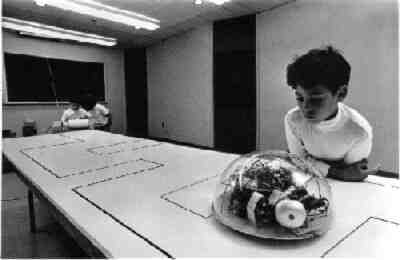
In 1972, BBN engineer Paul Wexelblat designed and built the first wireless floor turtle, dubbed "Irving". The first working turtle robot was created at MIT in 1969. (photo by Wallace Feurzeig, BBN).
The first working turtle robot [RH-the Yellow turtle] was created at MIT in 1969. A display turtle preceded the physical floor turtle. Modern Logo has not changed too much from the basic concepts before the first turtle. The first turtle was a tethered floor roamer, not radio-controlled or wireless. Later, BBN developed a turtle named Irving that had touch sensors and could move forwards, backwards, rotate, and ding its bell.
LOGO – A Project History
Anit Chakraborty, Randy Graebner, Tom Stocky
6.933J – 10 December 1999BBN continued work on the project for only a few more years. During this time, they focused on distributing and testing Logo in schools. One of their final contributions was the creation of the turtle. Paul Wexelblat implemented the first turtle named Irving.32
Children working at BBN with one of the first wireless turtle-robots (named
“Irving”) in the early 1970s (photo courtesy of Wallace Feurzeig, BBN).It was a relatively large robot that looked a bit like a moving dome on the ground, created to help children visualize what they were programming. By interacting with their environment (which contained the turtle) they could better understand the result of the programs they were creating in Logo. A small child could even ride around on it and, needless to say, they loved using it.33 Controlled by radio, it would respond to the commands given to the Logo interpreter running on the terminal. With this robot, kids could draw on the floor and watch it move around, creating an interactive learning environment.
32 Interview with Paul Wexelblat. November 3, 1999 via e-mail33 Interview with Hal Abelson. November 16, 1999 in his office at MIT LCS
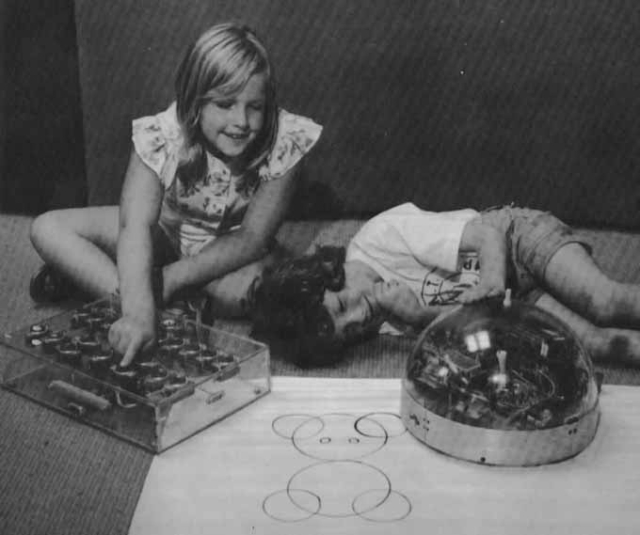
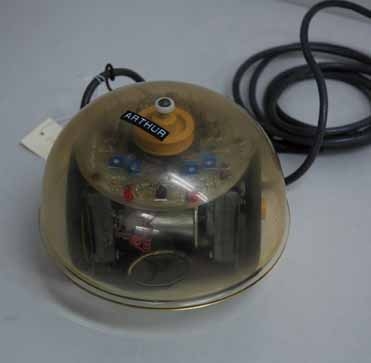
The above image is from the MIT Museum site. It's been said to be the original turtle, but it is very much a Terrapin Turtle (see below). Terrapin Logo was set up by ex-MIT Logo researchers, so its possibly the original Terrapin turtle and may have been built at MIT, but in my opinion it is not the original Logo turtle which I believe is the "Yellow" turtle. Note the name "Arthur" on the shell above.
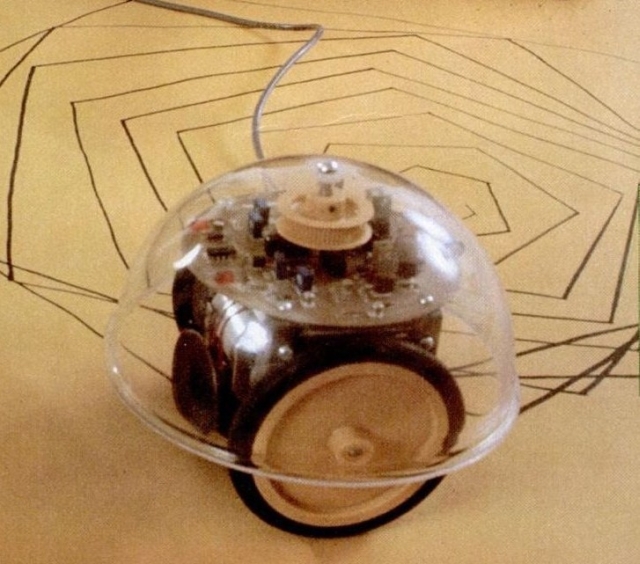
Above: Terrapin Turtle
A few turtles were built in the 70's. A quote from Peter Chapman re 1977)
"At 16 (1977 – so not original), my father pulls some strings with Marvin Minsky to work with the Logo Group at the A.I. Lab at M.I.T. Projects include building a floor turtle, programming the logo interpreter on a DEC PDP 8 and early attempts to engineer systems that exhibit intelligence."
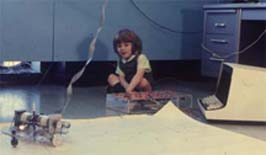
.jpg)
Radia Perlman's "Button Box" used to control the turtle using a Logo subset, TORTIS c 1974-6, hence dating this model turtle.
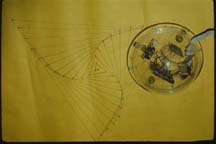
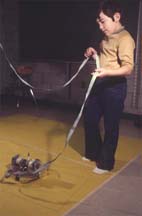
The above Turtle is said to be the second (tethered) version. (from Cynthia Solomon's logo site here.) The related video clip on her site shows both versions of the turtle in the same view.)
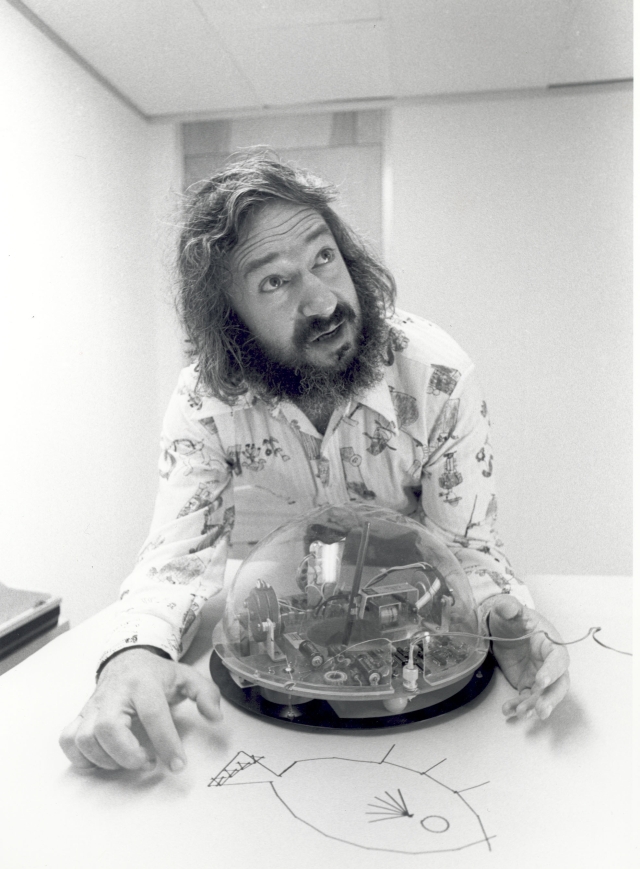
Seymour Papert with an as yet unidentified turtle.
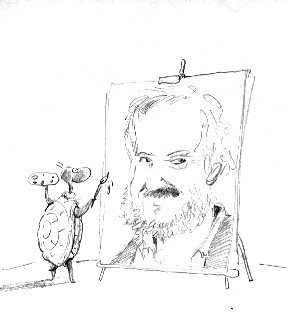
The Social Shaping of Logo
Author(s): Angelos Agalianos, Geoff Whitty, Richard Noss
Source: Social Studies of Science, Vol. 36, No. 2 (Apr., 2006), pp. 241-267
p255
Commercialization/Implementation Versus Technical Development
An additional consequence of the involvement of commercial companies was the creation of tension within the MIT Logo group itself, because – as we discussed earlier – a number of people in the group were in favour of more research and technical development of Logo instead of commercial ization and school implementation which was what the commercial com panies wanted.22 The fact that people from the Logo research group became affiliated with both the research team and the commercial com panies seemed to slow down research in favour of commercialization and implementation, a direction that members of the Laboratory who were in favour of research and technical development did not prefer. Lieberman remembers:
The attempt to commercialize created some tension as the companies took people away from doing research so the research group felt like some of the resources were being taken away to commercial companies. There were also individuals who had conflict of interest as they were affiliated both with the [MIT] research group and commercial companies. This surely happened with the first company 'General Turtle' … there was some uneasiness about who was involved in this company and who was not; also about to what extent the company was using resources of the Lab. … We thought that if the company was successful that would be a good thing for Logo. But there was always what the priorities were for the research versus the company. … When you get that kind of situation it always influences the development in that it sort of puts more emphasis on short-term objectives rather than long-term objectives. (Interview)
The view that commercial companies caused tension among the members of the research community who were involved is also supported by Brian Harvey:23
There was a kind of fragmentation of people's efforts. … There was Terrapin, and LCSI… and those companies came out of the same group of people, the MIT Logo Lab people. And there were other smaller companies. … It's hard to support all those different companies and people … and sometimes there are rivalries. So in the case of Apple, there were two different competing versions of Logo for the Apple. … There was the LCSI Logo and there was Terrapin Logo which was the one developed at MIT by Hal Abelson's group. And that was too bad because sometimes people didn't like each other; it was also too bad because the two versions were incompatible. (Interview)
Logo Down Under
by Jeff Richardson – 1996
[RH-2010 As it turns out, I know Jeff Richardson. Our daughters went to the same primary school together.]
The history of Logo in Australia begins in 1974. Scott Brownell, a teacher from the island state of Tasmania brought a magnetic tape copy of Logo from MIT to Hobart, to run on a PDP-11 at the Tasmanian Education Department's computer center. He then recruited another Tasmanian teacher, Sandra Wills, and secured a rare and expensive robot turtle from The General Turtle Co. The ensuing project saw every school in Tasmania connected, with a teletype terminal, to the PDP-11. Sandra would load the turtle into the boot of her car and travel all over the island, moving from school to school. At each school children would hook up the turtle to their terminal and use their remote Logo to control it. It's quite astonishing to think that some of these children are now in their 30s!
This work led to two technical breakthroughs in global Logo history. With the arrival of the Apple, personal computers came to rule the earth and distributed computing went into hiding for 15 years. Richard Miller, of the University of Wollongong in New South Wales, wrote the first version of Logo to run on the Apple, specifically to drive the robot turtles in the Tasmanian project. In addition to collaborating with Richard, Sandra Wills had overseen the engineering of a small and relatively inexpensive floor turtle, the Tassie Turtle. The Tassie Turtle achieved a degree of accuracy and precision that had eluded similar research and development efforts in Edinburgh and elsewhere. And it could be run from a 5.25" floppy disk on an Apple.
from "Mindstorms", Seymour Papert, 1980
Introduction p11
In the Foreword of this book I described how gears helped mathematical ideas to enter my life. Several qualities contributed to their effectiveness. First, they were part of my natural "landscape," embedded in the culture around me. This made it possible for me to find them myself and relate to them in my own fashion. Second, gears were part of the world of adults around me and through them I could relate to these people. Third, I could use my body to think about the gears. I could feel how gears turn by imagining by body turning. This made it possible for me to draw on my "body knowledge" to think about gear systems. And finally, because, in a very real sense, the relationship between gears contains a great deal of mathematical information, I could use the gears to think about formal systems. I have described the way in which the gears served as an "object-to-think-with." I made them that for myself in my own development as a mathematician. The gears have also served me as an object-to-think-with in my work as an educational researcher. My goal has been the design of other objects that children can make theirs for themselves and in their own ways. Much of this book will describe my path through this kind of research. I begin by describing one example of a constructed computational "object-to-think-with." This is the "Turtle."'
The central role of the Turtle in this book should not be taken to mean that I propose it as a panacea for all educational problems. I see it as a valuable educational object, but its principal role here is to serve as a model for other objects, yet to be invented. My interest is in the process of invention of "objects-to-think-with," objects in which there is an intersection of cultural presence, embedded knowledge, and the possibility for personal identification.
The Turtle is a computer-controlled cybernetic animal. It exists within the cognitive minicultures of the "LOGO environment," LOGO being the computer language in which communication with the Turtle takes place. The Turtle serves no other purpose than of being good to program and good to think with. Some Turtles are abstract objects that live on computer screens. Others, like the floor Turtles shown in the frontispiece are physical objects that can be picked up like any mechanical toy.Note 3. The history of the Turtle in the LOGO project is as follows. In 1968-1969, the first class of twelve "average" seventh-grade students at the Muzzy Junior High School in Lexington, Massachusetts, worked with LOGO through the whole school year in place of their normal mathematics curriculum. At that time the LOGO system had no graphics. The students wrote programs that could translate English to "Pig Latin," programs that could play games of strategy, and programs to generate concrete poetry. This was the first confirmation that LOGO was a learnable language for computer "novices." However, I wanted to see the demonstration extended to fifth graders, third graders, and ultimately to preschool children. It seemed obvious that even if the LOGO language was learnable at these ages, the programming topics would not be. I proposed the Turtle as a programming domain that could be interesting to people at all ages. This expectation has subsequently been borne out by experience, and the Turtle as a learning device has been widely adopted. Pioneer work in using the Turtle to teach very young children was done by Radia Perlman who demonstrated. while she was a student at MIT, that four-year-old children could learn to control mechanical Turtles. Cynthia Solomon used screen Turtles in the first demonstration that first graders could learn to program.
Practical Robotics Nov-Dec 1984
-EDUCATIONAL-
ROBOTICS
Anthony Ginn talks to Seymour Papert about the future
Giving maths power to the children
Could you talk about the history of Logo and robotic turtle?
Logo started with the idea that we could give children a sense of power over an important piece of technology, power over an important intellectual system through the computer. One of the real reasons for the failure of elementary education, in mathematics particularly, is that children are learning about ideas they cannot use. They do not have power over mathematics. What children like is to take it over and use it for their own purposes. So the computer was a way for them to take over mathematics.
They had to do something with the computer. An adult cannot simply provide a program to do an inventory like in business. A child is not interested in that. We searched around and tried many applications of computation which could be interesting to children. The three which become most dramatically useful, proven to be most fascinating for children and very rich in what the children can learn from them, are graphics, manipulating musical sound, sound effects — the kind of thing they see and hear in the movies.
Enjoy turtles
That corresponds to something in their lives; and robotics makes something move around. So of the three, for little children, robotics is the most powerful. It emerged out of a long set of experiments, trying things you could do with the computer that they would accept and enjoy, and which would be rich in intellectual content. That is how we arrived at the turtle.
The robotic turtle is being used less than the screen turtle for practical and economic reasons. A mechanical object is more expensive — it can break and so on. It occupies more space. On the other hand, we have become better at making these mechanical devices, the prices have fallen, and we now see more of them being used with children. I have seen that computer-controlled robots are now being made for less than £50. I can imagine a large number of parents will buy them for their children.
How do robots contribute to education?
First there is the general principle that you learn by doing. Programming the robot to do something helps a child to think about 'doing'. You learn by doing but you learn better by thinking about what you are doing. Getting a robot to do something compels you to think about what you are doing and so enhances the whole learning process. I think this is what is most important. That is what is so fascinating for children about a robot; it is like a mirror, they see themselves.
If you want to make this robot do something, do it yourself, describe what you are doing, and then translate your description into a program for the computer. Then, of course, the robot does something different from what you expect. So you go back and you look and you see that you did not really properly describe what you were doing. That leads to self-awareness, better use of language and, of course, it leads to better mathematics. It is rich in mathematical knowledge.
You say "Bend you arm this much" but you cannot say that to the robot. You have to say "Bend your arm 45 degrees." The idea of 45 degrees is meaningless to most children.
They have no room for it in their lives because they have no use for it but here they have a use for 45 degrees. It provides a field of action for mathematical ideas as well as self awareness. They have a use for it.
What differences do you notice nationally in the way robots and computers are used in education? There certainly are differences but they are difficult to pin down. For one thing you use more robots in Britain than they do in the United States. More robotic devices are used here to teach programming. In the States they used to screen graphics more. Of course, both are used in both places but there seems to be a preference for the actual robot in Britain. I think this might have something to do with a tradition in Britain of using very concrete objects for introducing young children to abstract thinking.
It might also have something to do with an accident; in Britain manufacturers made robots earlier than they made computers with good graphics. I do not know to what to attribute it but the fact is that there is much more work being done in Britain. When I come to Britain or visit projects, I see aspects of how children learn with computers which are new to me and different from things I see in the States.
The computer can support many different approaches to education. It can strengthen both sides. It could become an instrument for an Orwellian society with thought control or it could become an instrument for the flourishing of independent minds. Which it becomes is not a matter of debating or conferences about education. At the end it is a political issue. It will be decided politically.
In search of a beautiful mind
He was long a jewel of the MIT faculty. Now, after a devastating brain injury, mathematician Seymour Papert is struggling bravely to learn again how to think like, speak like, be like the man of genius he was.
Seymour Papert constructed a mobile as part of his neurotherapy at his house in Blue Hill, Maine. The former MIT mathematics professor suffered massive brain trauma when he was struck by a motorbike. (Fred Field for The Boston Globe)
By Linda Matchan – Globe Staff / July 12, 2008
BLUE HILL, Maine – Seymour Papert is tinkering with a robotic, computer-controlled turtle in The Learning Barn, the rustic, light-filled laboratory where he developed and refined many of his ideas.
Video Reinventing Seymour Papert
The long table he sits at is covered with relics of his prodigious career. A super-inexpensive laptop computer – based on his ideas – that originated at the MIT Media Laboratory, where he was a founding faculty member. A pile of DVDs on higher mathematics. A truck that brings to mind Papert's work in developing a line of robotic toys made of Legos. His turtle, a device to teach children to program computers.
Papert, who was a professor of mathematics, education, and media technology at MIT, has devoted much of his career to learning: self-learning (he taught himself Russian) and learning about learning. He was one of the early pioneers of artificial intelligence, and he invented the computer language Logo to teach children about computers.
Now he must learn something even more challenging – how to be Seymour Papert again.
Nineteen months ago he was struck by a motorbike in Hanoi and suffered a brain injury so severe he was comatose for a month and couldn't walk, talk, or read. The man widely considered to be the most important living thinker about the way children learn is struggling with an unreliable memory and an uncertain grip on words. And his wife and his caregivers are using insights from his theories about learning to help bring him back to a normal life.
"His accident was worse than horrible for somebody whose life was the mind," said Nicholas Negroponte, a cofounder and former director of MIT Media Laboratory.
It's been a year since Papert came home to Blue Hill on the Maine coast, where he lives with his wife, Suzanne Massie, a writer and Russian scholar. He'd spent months in hospitals and rehabilitation facilities. Doctors say it could take years to know the full extent of the brain damage.
He spends every weekday in The Learning Barn. Here, with friends and aides, he plays dominoes to practice working with numbers. He adjusts gears on a Lego truck, an echo of a lifelong passion for gears so exuberant he wrote an essay about them – "The Gears of My Childhood" – in his seminal 1980 book, "Mindstorms: Children, Computers, and Powerful Ideas." He works, tentatively, on math problems and is starting to play chess.
"He is unbelievably brave and courageous," Massie said. "I've come to the conclusion that the good Lord still wants him to do some work."
The accident
When the accident happened on Dec. 5, 2006, Papert was 78 years old and as vigorous as ever.
The South Africa native was midway through an ambitious new book about the future of education. He'd just returned from Greece, where he lectured at an international educational conference. He had a meeting coming up with the king of Thailand to talk about new learning initiatives in Bangkok. Though he'd retired from MIT in 1996, he worked under contract as a consultant with doctoral students, gave lectures, and attended faculty meetings.
He had been invited to Vietnam to deliver the keynote speech at a conference of mathematicians and educators hosted by Hanoi Technology University. The speech he gave was vintage Papert. With his eloquent command of language and thoughtful discourse, he challenged the audience to help students embrace "the beautiful jewel of the human spirit called pure mathematics" and to "think beyond the possible, beyond what you think can be done."
The next day he went back to the conference and was struck by a speeding motorbike as he crossed a chaotically busy street. He was rushed to a Hanoi hospital, where he had two emergency brain operations. A few days later he was airlifted, in a coma, to Massachusetts General Hospital in a Swiss air ambulance.
He spent nearly a month in intensive care and seven months in Maine hospitals and rehabilitation facilities, at one point developing septicemia, an infection that nearly killed him. Last July, he returned home to the light-filled 1839 farmhouse adjoining The Learning Barn in this picturesque coastal community.
He was a very changed man. He'd lost nearly 40 pounds and used a wheelchair and a walker. His speech was totally garbled. He was relearning how to feed himself. He had bouts of extreme anxiety and was terrified of stairs.
With some trepidation, Massie began helping her husband become himself again, the man she describes as charming, funny, a deep thinker, a "constant learner," a scientist so fully engaged he often neglected to tie his shoes.
Doctors prescribed 24-hour home care, Massie said, while offering no assurances he'd recover completely. "Memory and other high-level thought functions take a long time [to return]. It can take years," said Dr. Douglas Katz, medical director of Braintree Rehabilitation Hospital's brain injury program, who was asked to consult on Papert's case.
"We wait," said Massie. "We wait."
But not passively. "I will say there certainly were times [with Papert] when I got pretty depressed," she says. But she clung to hopeful advice offered by a physician in Hanoi. "He said, 'It's a good thing he is so brilliant; it means his neurons are well developed,' " Massie said. " 'Put him to work at something hard as soon as possible.' "
She did. Inspired by Papert's own ideas on experiential, hands-on learning, she encouraged friends and colleagues to relate to him as the mathematician and thinker they'd always known. Colleagues brought learning toys and puzzles to the hospital. "Past colleagues would come with gears," said Dr. Peter Keebler, chief of rehabilitation at Eastern Maine Medical Center in Bangor, where Papert spent several weeks. "In a sense they were applying his own paradigms for learning."
Exercising his mind
Four mornings a week, Papert works with Peter Rottman, a friend and executive director of The Learning Barn, who engages him in conversation and reminds him of the theories he constructed and the work he used to do.
"I ask open-ended questions," said Rottman. "I never know where we'll end up."
Much of the time he talks to Rottman in a kind of gibberish, using nonsense words and sentences, albeit with the syntax and the cadence of proper sentence construction.
Rottman observes that Papert still speaks in his old professorial manner, drawing circles with his finger on the table, interjecting terminology – "data," "robot," "key ideas" – from his academic days at MIT. Even when he speaks nonsensically, it's with a South Africa accent and a tendency to pontificate.
Their starting point, one recent morning, was Papert's work with children at MIT Media Lab.
"Are children still using the robots?" Rottman asked.
Papert paused and appeared to reflect. "For this particular group of kids, something of kinetic directed very started getting this moving," he responded authoritatively, but then lapsed: "So a lot of children gradually are taken vocay and the convense."
"When I talk to you," Rottman said, "do you understand everything I say?"
Papert nodded. "Somewhat," he said, and smiled.
Rottman said it's disconcerting, sometimes, to watch Papert speak and know he's conveying only a small percentage of what he's thinking. "When he's talking to you, obviously in his mind it's correct, but coming out of his mouth it's not. Every now and then he'll string together three or four sentences and they'll just be perfect," Rottman said. "But if he can put together three or four, why not five or six? That's the fascinating part. We don't know."
Searching for Seymour
Papert has a devoted group of caregivers working around the clock, including nurses, a physical trainer, and a speech therapist. The services cost $15,000 a month, Massie said, and since Papert has used up his Medicare and Blue Cross benefits, she was forced to launch a Seymour Papert Recovery Fund, which has generated donations from colleagues and friends all over the world, as well as the Lego company. She said MIT has refused to help pay for his home care, although it did cover his emergency evacuation from Hanoi.
In a statement, MIT said: "Seymour Papert, a retired professor emeritus at MIT since 1996, has been a member of the MIT community for over 40 years and is loved and respected by everyone who has had the privilege of working with him. Since his terrible accident in Hanoi, MIT has provided him with assistance and support."
At the end of March, Massie brought Papert to MIT for the first time since the accident to visit his old colleagues at the Media Lab. "I hope he understood what was being said," Nicholas Negroponte said via e-mail, adding: "It did not feel like the same Seymour."
Massie is convinced it is the same Seymour.
Rottman, for his part, is heartened by the continual improvements in Papert's speech. "At the very beginning, I think he was confused. He wasn't very aware of his surroundings. Now he seems much more aware."
Then he turned to Papert to get his perspective. "Think that will change, Seymour?" he asked.
"I don't know," Papert replied with a shrug. "We'll see."
© Copyright 2008 Globe Newspaper Company.
I mentioned in my introduction the W. Grey Walter corollary to this story. Here it is:
W. Grey Walter – (1910-1977),
- Neurophysiologist
- Life-long contribution about the functioning of the human brain.
- Designer and builder of the world's first autonomous robots, and later with conditioned reflex behaviour.
(see Grey Walter's full bio here.)
On June 13, 1970, whilst on his way home from work, Grey Walter, aged 60 had an accident on his Vespa scooter when he tried to avoid a run-away horse. He was unconscious for about 3 weeks.
After Grey Walter had his road accident, he wrote about it in a paper called "My Miracle" .
From email with Ray Cooper Sep 2007 "As a physicist I joined the staff of the Burden Neurological Institure in 1955 and worked with Grey until 1970 when he had a road accident (and I became Director). He did no significant work from that time and died in 1977 from an unrelated illness…….From 1960 Grey lived with Lorraine Aldridge who could not cope with Grey's mental disability after his accident and left him in 1972."
From email with Peter Bladin March 2009 "When I was in London at Queen Square, my then chief Dr Bill Cobb, knew Grey very well and I met him on several occasions – a delightful man, and very helpful to those seeking a career in EEG. His accident changed him – not as far as his geniality went, but the spark had gone.
…..I understand that it was not an auto accident – he rode a motor scooter and ran into a horse that had escaped onto the roads and he was badly knocked around. However the real problem was respiratory arrest in the ER – and this does no favours to the frontal lobes." [RH 2010-Ironic that his accident effectively gave him a leucotomy (frontal lobotomy) that he himself practiced and advocated early in the piece!].
"I hear and I forget; I see and I remember; I do and I understand."
Re- the adoption of Turtle’s in the UK.
I think there were several reasons for it. Ellen Lagemann said, “You cannot understand the history of education in the USA without realising that Thorndike won and Dewey lost”. While education researchers preach progressive education it rarely happens in schools. The UK however was under the spell of Piaget. This had been fueled by the Plowden report. Maurice Meredith working at the National Computing Centre in Manchester also recalls how they thought students should understand computers in a broader sense than things that sit on the desk top. Computers were also thing built into machines. All this made schools very receptive to the idea of Logo and Turtles. Then of course two companies provided the robots Jessop Turtle followed by the Valiant Turtle. The Valiant Turtle was a great success and was in continuous production from 1983 until 2010. There was some initial support from the Chief Inspector for Schools – Gabriel Goldstein. He recommended Logo and Turtles and funded a small Turtle project at a very crucial time. The next step was Valiant’s introduction of Roamer in 1989. This was a combination of Turtle an Big Trak. 1990 saw Swallow systems introduce PIP which was a similar idea. Later Duncan Loutitt of Swallow introduced Pixie – a very simple programmable toy that migrated the robot from floor to desktop. Then circa 2007 TTS made a verion of Pixie called BeeBot. There is not a school in the UK who does not have a robot.
Fascinating! It really makes me want to put computing in children’s hands.
hi,
thank you, this is great!